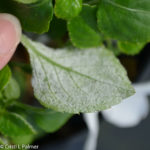
Over a 5-year timeframe starting in 2013, the team of researchers listed above investigated several downy mildews – Impatiens and Cucurbit, primarily, for biology, epidemiology, genomics, diagnostics, and mitigation. USDA-APHIS provided funding for this research via a series of cooperative agreements with Michigan State University and Rutgers University (the IR-4 Project). Throughout this project, this team made several key discoveries. First, Impatiens Downy Mildew (IDM) overwinters as oospores – thick walled resting spores – in stems of common garden impatiens (I. walleriana) and in seeds of balsam impatiens (I. balsamina). Second, alternative hosts are available and can potentially serve as reservoirs for inoculum for both IDM and cucurbit downy mildew (CDM). Third, collecting diverse populations of downy mildews (IDM, CDM and downy mildews of hops, basil) have yielded richer genomic resources that in turn has fostered improved understanding of population dynamics and has provided the basis for new genomic-based diagnostic tools (spore trapping + PCR for CDM, and FISH assay for IDM). Genomics has also identified several new downy mildew species affecting cucurbit hosts. Fourth, screening for mitigation options highlighted the critical need to develop and maintain robust rotational programs to minimize resistance development and spread. Pockets of transient resistance were noted for mefenoxam and fluopicolide in Plasmopara obuscens, the IDM pathogen.
In addition to being highly prolific researchers, this team has been highly prolific in outreach. This group has prepared and published or presented 25 scientific abstracts/posters, 51 oral scientific presentations, 27 scientific manuscripts, 24 Plant Disease Management Reports, 163 oral extension presentations, 14 trade journal articles, 26 online & print extensions bulletins, plus field days, news releases, and popular press interviews. Plus, this team hosted a final summary to APHIS personnel to present outcomes and future research pathways.


